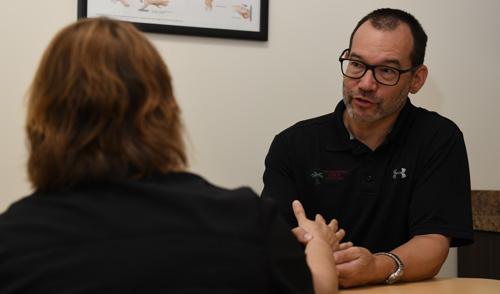Digital Nerve Repair
![]() Nerves are part of the "electrical wiring" system that carries messages between the brain and the rest of our body, including the hand and fingers. A ring of tissue covers the nerve, protecting it just like the insulation surrounding an electrical cable. Nerves are composed of many fibers, called axons, that are separated into bundles within the nerve.
Nerves are part of the "electrical wiring" system that carries messages between the brain and the rest of our body, including the hand and fingers. A ring of tissue covers the nerve, protecting it just like the insulation surrounding an electrical cable. Nerves are composed of many fibers, called axons, that are separated into bundles within the nerve.
 Nerves are fragile and can be damaged by pressure, stretching, or cutting. Pressure or stretching injuries can cause the fibers carrying the information to break and stop the nerve from working, without disrupting the insulating cover. When a nerve is cut, both the nerve and the insulation are broken. Injury to a nerve can stop the transmission of signals to and from the brain, preventing muscles from working and causing loss of feeling in the area supplied by that nerve.
Nerves are fragile and can be damaged by pressure, stretching, or cutting. Pressure or stretching injuries can cause the fibers carrying the information to break and stop the nerve from working, without disrupting the insulating cover. When a nerve is cut, both the nerve and the insulation are broken. Injury to a nerve can stop the transmission of signals to and from the brain, preventing muscles from working and causing loss of feeling in the area supplied by that nerve.
To fix a cut nerve, the insulation around both ends of the nerve is sewn together. A nerve in a finger is only as thick as a piece of thin spaghetti, so the stitches have to be very thin and tiny. The goal in fixing the nerve is to save the insulating cover so that new fibers can grow and the nerve can work again. The goal of this microsurgical procedure is to reconnect the severed ends of a nerve in the hand to allow it to heal and to reduce the possibility that a neuroma will form. A neuroma is a nerve scar that can be painful and cause an electrical feeling when touched.
Once the insulating covering of the nerve is repaired, the nerve generally begins to heal three or four weeks after the injury. Nerves usually grow one inch every month, depending on the patient’s age and other factors. The feeling of pins and needles in the fingertips is common during the recovery process. While this can be uncomfortable, it usually passes and is a sign of recovery.
There are several things that can be done to keep up muscle activity and feeling while waiting for the nerve to heal. Your Celebration Orthopaedics hand surgeon may schedule visits with our occupational therapists. They will design a physical therapy program for you that helps keep the joints flexible. If the joints become stiff, they will not work, even after the muscles begin to work again.
Factors that may affect results after nerve repair include age, the type of wound and nerve, and location of the injury. Although nerve injuries in the hand may create lasting problems for the patient, care by your Celebration Orthopaedics hand surgeon and occupational therapists will help you return to normal use.
